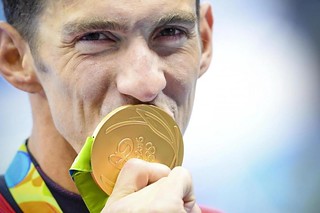
PREV ARTICLE
NEXT ARTICLE
FULL ISSUE
PREV FULL ISSUE
HOW MUCH ARE OLYMPIC MEDALS WORTH?
This article from the Washington Post published August 12 discusses the collector value of Olympic medals. -Editor
He also owns a lot of precious metal. After 22 gold medals in four Olympic games, if Phelps wanted to sell his collection it would probably fetch millions of dollars, sports memorabilia appraisers say. Olympic gold medals have a tiny but dedicated collector following. A single medal from a modern Olympiad is worth upward of $30,000, depending on the athlete. Ukrainian boxer Wladimir Klitschko sold his 1994 medal for $1 million in 2012. Mark Wells, a member of the 1980 “Miracle on Ice” U.S. hockey team, sold his in 2002 for $40,000. Phelps’s medals are worth at least $100,000 a pop, maybe more if they're from an especially noteworthy race. The legend of Michael Phelps, the most awarded Olympic athlete of all time, is worth a whole lot of money. "There’s something about what just happened [in Rio de Janeiro] that makes him different,” said Brian Steiner, the chief executive of memorabilia appraisal at auction house Steiner Sports. “This was the one that somehow catapulted him to some other kind of greatness.” As scrap metal, Phelps’s golds are worth more than $10,000. “Gold” medals since the 1912 games in Stockholm aren’t actually made of gold. They’re gold-plated — about 1 percent gold — with the rest an alloy of silver and copper. The Rio gold medals weigh 500 grams, the heaviest medal ever awarded in a summer games. So far, Phelps has won four of them. That’s $1,144.80 worth of gold this year and another $1,320.60 in silver. With awards there is an intrinsic value, but with medals it’s really only what is without any intrinsic value,” said Mike Provenzale, sports production manager at Heritage Auctions. “It’s all about what it is and not what it’s made of.” Heritage sells a lot of NBA and NFL championship rings loaded with diamonds and gold. Those do have intrinsic value, Provenzale said. As a gaudy ring, it’s probably worth $10,000. But buyers will spend $20,000 on them: half for the cost of the materials, half because they really love their favorite teams. Olympic medals, even vintage medals, don’t work like that. Heritage is selling a diving medal from the 1936 games in Berlin. It’s intrinsic value, adjusted for 2016 gold and silver prices, is less than $100. Provenzale still expects it to sell at auction at the end of the month for more than $20,000. To read the complete article, see:
On a related Olympic note, did you know there once was a medal category for architectural design? -Editor
The design to redevelop Marine Park, in Brooklyn, had been beautifully sketched in oil onto a large rectangular canvas. The map showed a thin canal, almost perpendicular to the South Brooklyn shoreline, which ran into a circular pool. It lay ready for inspection in a spacious exhibition hall, just outside the monumental Olympic Stadium in Berlin. The drawings, signed in a calligraphic style on the bottom righthand corner by their creator Charles Downing Lay, were the American entry into the 1936 Summer Olympics—also known as the Nazi Olympics—for a category that seems improbable today: Town Planning. Yes, from 1928 until 1948, town planning was an actual Olympic sport. Town planning fell under an "architectural design" category at the Olympic art competition. The field that year was dominated by German entries. Yet the first U.S. medal of the Olympics went to Lay, a New York architect, for his ambitious blueprint to modernize Marine Park in Brooklyn.
So where is that medal today? I was unaware of the architectural design category until I saw this article. -Editor
To read the complete article, see:
Here's another interesting article about the detective work that uncovered the fact that the first American woman to win an Olympic
event never knew about it. -Editor
The first American woman to win an Olympic gold medal wasn’t aware of what she’d won. In fact, records suggest she went her entire life oblivious to her historic achievement—and if it weren't for one professor's decade of detective work, the story of top prizewinner Margaret Abbott would still be unknown to the world. To read the complete article, see:
THE BOOK BAZARREWayne Homren, Editor The Numismatic Bibliomania Society is a non-profit organization promoting numismatic literature. See our web site at coinbooks.org. To submit items for publication in The E-Sylum, write to the Editor at this address: whomren@gmail.com To subscribe go to: https://my.binhost.com/lists/listinfo/esylum All Rights Reserved. NBS Home Page Contact the NBS webmaster 
|
